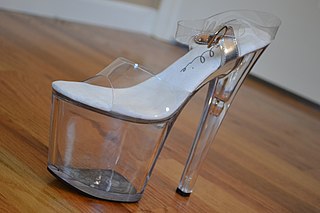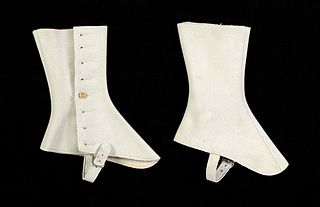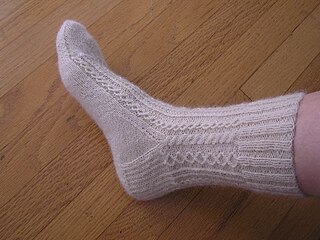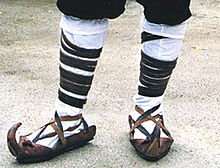
A shoe is an item of footwear intended to protect and comfort the human foot. Though the human foot can adapt to varied terrains and climate conditions, it is vulnerable, and shoes provide protection. Form was originally tied to function, but over time, shoes also became fashion items. Some shoes are worn as safety equipment, such as steel-toe boots, which are required footwear at industrial worksites.

Flip-flops are a type of light sandal-like shoe, typically worn as a form of casual footwear. They consist of a flat sole held loosely on the foot by a Y-shaped strap known as a toe thong that passes between the first and second toes and around both sides of the foot. This style of footwear has been worn by people of many cultures throughout the world, originating as early as the ancient Egyptians in 1500 BC. In the United States the modern flip-flop may have had its design taken from the traditional Japanese zōri, after World War II as soldiers brought them back from Japan.

Zori, also rendered as zōri, are thonged Japanese sandals made of rice straw, cloth, lacquered wood, leather, rubber, or—most commonly and informally—synthetic materials. They are a slip-on descendant of the tied-on waraji sandal.

Espadrilles are casual, rope-soled, flat but sometimes high-heeled shoes. They usually have a canvas or cotton fabric upper and a flexible sole made of esparto rope. The esparto rope sole is the defining characteristic of an espadrille; the uppers vary widely in style.

Waraji are light tie-on sandals, made from ropemaking fibers, that were the standard footwear of the common people in Japan.

Platform shoes are shoes, boots, or sandals with a thick sole, usually in the range of 3–10 cm (1–4 in). Platform shoes may also be high heels, in which case the heel is raised significantly higher than the ball of the foot. Extreme heights, of both the sole and heel, can be found in fetish footwear such as ballet boots, where the sole may be up to 20 cm (8 in) high and the heels up to 40 cm (16 in) or more. The sole of a platform shoe can have a continuous uniform thickness, have a wedge, a separate block or a stiletto heel. Raising the ankle increases the risk of a sprained ankle.

Sandals are an open type of shoe, consisting of a sole held to the wearer's foot by straps going over the instep and around the ankle. Sandals can also have a heel. While the distinction between sandals and other types of footwear can sometimes be blurry, the common understanding is that a sandal leaves all or most of the foot exposed. People may choose to wear sandals for several reasons, among them comfort in warm weather, economy, and as a fashion choice. Usually, people wear sandals in warmer climates or during warmer parts of the year in order to keep their feet cool and dry. The risk of developing athlete's foot is lower than with enclosed shoes, and the wearing of sandals may be part of the treatment regimen for such an infection.

A sabaton or solleret is part of a knight's body armor that covers the foot.

Opanci are traditional peasant shoes worn in Southeastern Europe. The attributes of the opanci are a construction of leather, lack of laces, durable, and various endings on toes. In Serbia, the design of the horn-like ending on toes indicates the region of origin, though this specific design is not exclusive to Serbia. The opanci are also considered as the traditional peasant footwear for people in the Balkan region. In Bulgaria they are referred to as "tsarvuli".

Spats, a shortening of spatterdashes, or spatter guards are a type of footwear accessory for outdoor wear, covering the instep and the ankle. Spats are distinct from gaiters, which are garments worn over the lower trouser leg as well as the shoe.

Gaiters are garments worn over the shoe and bottom of the pant or trouser leg, and used primarily as personal protective equipment; similar garments used primarily for display are spats.

Wedge boots, wedgies, or lifties are shoes and boots with a sole in the form of a wedge, such that one piece of material, normally rubber, serves as both the sole and the heel.

Ciociaria is the name commonly used, in modern times, for some impoverished territories southeast of Rome, without defined geographical limits. Starting from the Fascist period and the creation of the province of Frosinone, the same name was arbitrarily imposed by the local fascist organizations and then misused by the local press, by promotional associations and folkloristic events as a synonym for Frosinone and all the popular traditions of its territory. The local dialect is referred to as campanino in old literature. It is merely a local variants of Central-Italian Latian but is improperly indicated as "ciociaro dialect", although the linguistic and scientific definition is Central-Northern Latian. In more recent times, the term Campagna Romana, or Roman Campagna, a favorite subject of countless painters from all over Europe, has referred to the adjoining region to the north of Ciociaria, but part of the Province of Rome.
In Italian literature, some folkloric words like Ciociaria and ciociari are used to denote people, film settings, and characters in Italian neorealist works.

Romanian dress refers to the traditional clothing worn by Romanians, who live primarily in Romania and Moldova, with smaller communities in Ukraine and Serbia. Today, the vast majority of Romanians wear modern-style dress on most occasions, and the garments described here largely fell out of use during the 20th century. However, they can still be seen in more remote areas, on special occasions, and at ethnographic and folk events. Each historical region has its own specific variety of costumes.

A sock is a piece of clothing worn on the feet and often covering the ankle or some part of the calf. Some types of shoes or boots are typically worn over socks. In ancient times, socks were made from leather or matted animal hair. In the late 16th century, machine-knit socks were first produced. Until the 1800s, both hand-made and machine-knit socks were manufactured, with the latter technique becoming more common in the 19th century, and continuing until the modern day.
The Medieval period in England is usually classified as the time between the fall of the Roman Empire to the beginning of the Renaissance, roughly the years AD 410–1485. For various peoples living in England, the Anglo-Saxons, Anglo-Danes, Normans and Britons, clothing in the medieval era differed widely for men and women as well as for different classes in the social hierarchy. The general styles of Early medieval European dress were shared in England. In the later part of the period, men's clothing changed much more rapidly than women's styles. Clothes were very expensive and both the men and women of lower social classes continued also divided social classes by regulating the colors and styles these various ranks were permitted to wear. In the early Middle Ages, clothing was typically simple and, particularly in the case of lower-class peoples, served only basic utilitarian functions such as modesty and protection from the elements. As time went on the advent of more advanced textile techniques and increased international relations, clothing gradually got more and more intricate and elegant, even with those under the wealthy classes, up into the renaissance.
Pointed or pointy shoe or shoes may refer to:
Upanah (Sanskrit) is an ancient form of footwear from India. The term is used to refer to several types of strapped sandals and shoes employed by common people, in contrast to monks and mendicants who would use paduka instead. The word comes from the Sansakrit root nah, meaning "to tie", "to bind", to "fasten", as well as pad, meaning "foot". Combined words like charan-upanah might have originated modern words like "chappal".

The carbatina was a kind of shoe common among the rural poor of ancient Greece and Rome from remote antiquity to around the 3rd century, consisting of a piece of rawhide pulled around the foot and then tied down to hold it in place. Having no upper or separate sole, the carbatina is among the simplest forms of footwear in the world and is sometimes used as a general name for similar footwear in other cultures.

















